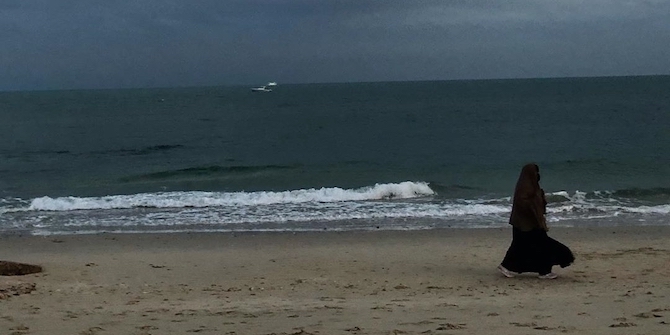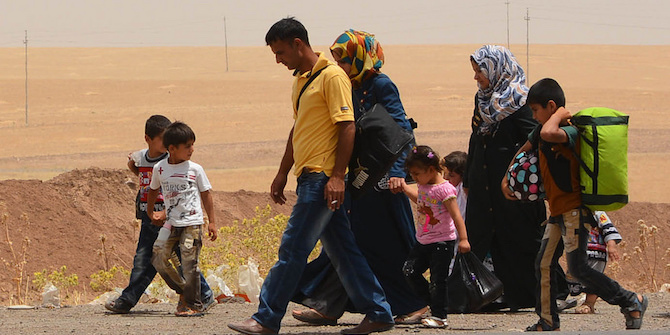by Alanoud Al-Sharekh

As the 2019 football Gulf Cup heated up in Doha last November, social media messages were exchanged on the upcoming game between ‘Ikhwan Mariam’ and ‘Ikhwan Noura’ – ‘Mariam’s brothers’ and ‘Noura’s brothers’ – a shorthand for the ruling Al Sabah family in Kuwait and the Al Saud family in Saudi Arabia. Despite these national myths being omnipresent in both Kuwait and Saudi Arabia, very little is known about Mariam Al Sabah herself outside of her name being a calling card for Kuwaiti male bravery.
So who was she? Mariam was the daughter of the second ruler of Kuwait, Abdullah I, who ruled from 1762–1812. Legend has it that news of her beauty reached the Sheikh of the Bani Kaab tribe and he asked for her hand in marriage. The Al Sabah family rejected the marriage and any consequent alliance and in doing so they incurred the anger of the Bani Kaab, who prepared for a naval attack. This sparked the first battle in Kuwait’s history, at al-Riqa off the coast of Failaka Island. Though outmatched in numbers and military prowess, the Kuwaitis won this battle and since then the ruling family have linked their bravery, and by extension Kuwait, to Mariam’s name and the battle fought to preserve her honour. The historian Abdulaziz al Rushaid contends that the marriage proposal was a ‘ruse’ to help establish the Al Sabah’s political control, which Saif al Shamlan corroborates in his book on the history of Kuwait, as does Dr Maymouna Al Sabah, President of Kuwait’s Historical Society, in the first volume of her historical series on Kuwait. And yet in all three accounts Mariam herself is visibly absent from the action.
In 2013 the annual national operetta held at Bayan Palace had a vignette on ‘Ikhwan Mariam’ which did not feature the female protagonist. The song lyrics that dealt with the battle only mention her to highlight the importance of protecting purity of lineage and obeying the call to nakhwa; a mixture of chivalry, bravery and responding to a call for help, especially to preserve honour. The ‘Ikhwan Mariam’ TV series, launched in 2010, attracted criticism for being historically inaccurate and the episodes that were aired also did not give the Mariam of the title much prominence. A school built in Jabriya in her name in 2006 misrepresented what Alaan newspaper called ‘the oldest female historical figure in Kuwait’ as the daughter of Sabah I, instead of the daughter of Abdullah I. There is no substantial mention of her in the Al Sabah historical museum, set to formally open in 2020, or of any other females in the Al Sabah family, since the focus is primarily on rulers, who have always been men. This systematic erasure of females from familial and institutional historical heritage recalls the work of Saudi artist Manal al Dowayan entitled The Tree of Guardians, which examines how women were left out of the historical records of their own families. While women are a ‘symbolic and emotional catalyst for the nation’ and for the call to action in these national myths, ‘the nationalizing of identity makes woman visible while ascribing invisibility to her.’ We can see this play out in the glorification of these male nakhwa tribal myths and the insistence by male historians and academics that they somehow honour the absent female figure.
Sulaiman al Fulaih lists many of the different myths using the ‘I’m the brother of (some woman)’ formula in the Gulf in an Al-Riyadh article ironically entitled ‘Women’s Elevated Position [in the expression] “the brother of (some woman)”’, without acknowledging this dismissive view of women’s contributions or how these myths reduce them to two dimensional accessories. Women are abstract symbols of tribal male bravery and warrior prowess in many variations of this female nakhwa practice across the Arabian Peninsula, in which – with the notable exception of Noura Al Saud, King Abdulaziz’s sister who is honoured at multiple sites in Saudi Arabia for her active role as consort to her brother – women are not generally agents of their own destiny.
Mohammed al Marur equates using these nakhwa phrases with a bygone era of chivalry, generosity and community, before ‘material wealth and obsession with job titles corrupted our societies’ in an article in Al-Ittihad entitled ‘Brothers of Shamma’, the moniker given to the Al Nuhayan ruling family and used in reference to Emirati nationals. He thinks that teaching heritage and Islamic values using stories like that of Shamma is the best way to preserve traditional morals. In Dr Salam al Tunaiji’s telling of the incident in his book about Emirati history and morality, Shamma is an orphan of unknown origin who is mistreated by her husband’s family due to her lack of known lineage. The Al Hummaid princes agree to pretend to be her siblings after feeling sorry for her following a chance encounter in the desert. They then present themselves as such to her perplexed husband and in-laws who are impressed by their ‘obvious wealth and sheikh-ly horses’ and promise not to harm her anymore under threat of divorce. The Al Hummaids then go on to chase away thieves who had been terrorising Shamma’s in-laws, all the while using ‘Ikhwan Shamma’ as their war cry. Following their victory, Shamma then lives as a precious Sheikha amongst her former abusers until her death. Shamma’s story is a repetition of the common trope of the female underdog rescued by tribal men, with her only contribution being her tears and a false claim to a better lineage.
Julie Murtis argues that ‘there is a gender component to everything from the creation and perpetuation of shared myths to the establishment of common boundaries…Women, for example, provide the blood-line that determines citizenship in many nations. In the national folklore of most nations women are the procreators, the symbol of the motherland, the political victims, and not the political actors.’ The essentialist view of women in these tribal and now national myths solidify both a nationalist cohesion around ‘our women’ and the male guardianship that underpins much of the social and legal practices in the Gulf states. Much of what is recorded about desert life and tribal heritage in academia comes from the works of Western explorers, whose experiences are filtered through their own cultural lens, and who were also not often exposed to women and thus fortify these myths with little or no reference to female contributions in their recollections. To rewrite women into history, and to bring back the importance of tribal female ancestors, we must begin by insisting that they be included in family trees, as the ruling families of the Gulf states have started to do recently, and encourage the alternative narratives presented by female historians such as Saudi Shura Council member Professor Dalal al Harbi who has written several books highlighting the role of women in Najd and in the Arabian peninsula from the mid-eighteenth century to the present. Historical records in general have omitted women’s voices, not because they were silent but because many led from the rear, guiding male decision makers and contributing much in the absence of men in the desert or at sea. They were more than valuable assets as daughters and mothers in forging tribal alliances, and these often untold tales are necessary to uncover and learn from, that our past social conditions may guide how we can better represent women in our present. Mariam will continue to be the subject of our chivalry legends, but it is time we heard her side of the story.
This is part of a series emerging from a workshop on ‘Heritage and National Identity Construction in the Gulf’ held at LSE on 5–6 December 2019. Read the introduction here, and see the other pieces below.
In this series:
- Introduction by Courtney Freer
- Souvenir Sovereignty in Qatar by Suzi Mirgani
- Examining Kuwait National Museum by Sundus Alrashid
- Urban Planning and its Legacy in Kuwait by Alexandra Gomes
- Museums as Political Institutions of National Identity Reproduction: Are Gulf States an Exception? by İdil Akıncı
- The New Populist Nationalism in Saudi Arabia: Imagined Utopia by Royal Decree by Madawi Al-Rasheed
- Heritage and Sectarianism in Bahrain by Thomas Fibiger
- Dubai Expo 2020 and Ancient Mercantile Heritage by Robert Mogielnicki
- Managing UNESCO World Heritage Sites in Saudi Arabia: Contribution and Future Directions by Abdulelah Al-Tokhais
- Cultural Attendance: Attracting the Crowds to Museums in Saudi Arabia by Maha al-Senan
- Religion and Heritage in the Gulf: Significant in its Absence? by Courtney Freer
- Historical Archaeology in the Gulf by Robert Carter
- Militarised Nationalism in the Gulf Monarchies: Crafting the Heritage of Tomorrow by Eleonora Ardemagni
- The Practice of Heritage in the Northern United Arab Emirates by Matthew MacLean
- Displaying the Nation in Museum Exhibitions in Qatar by Alexandra Bounia
- Implicit and Explicit Cultural Policies in Qatar: Contemporary Art Production and Censorship by Serena Iervolino
- The UAE State ‘Rebirthing’ of Motherhood: Who is birthing who? by Rima Sabban






